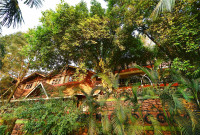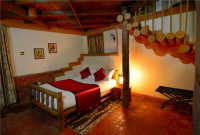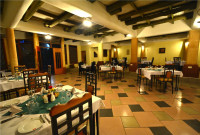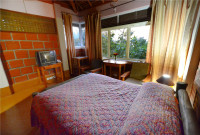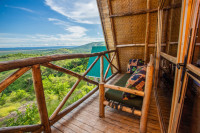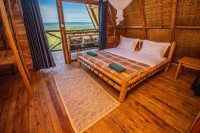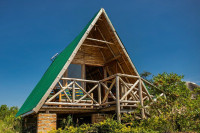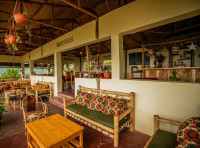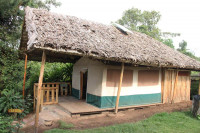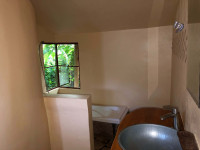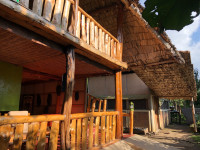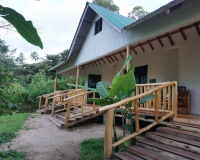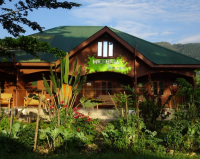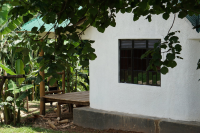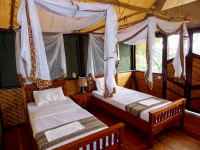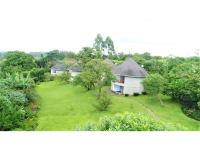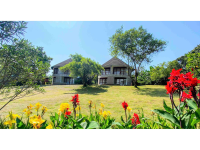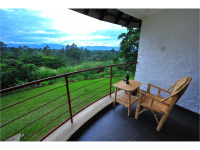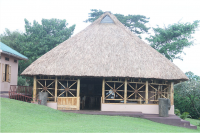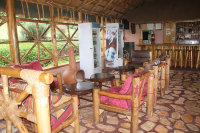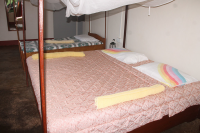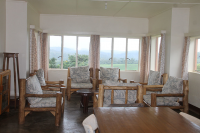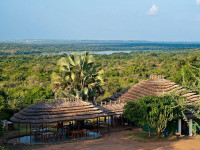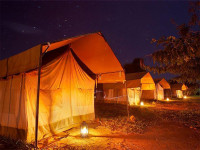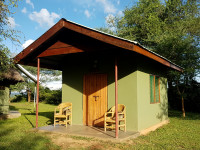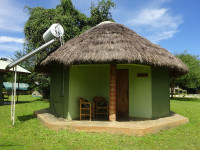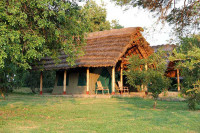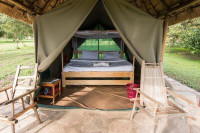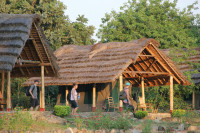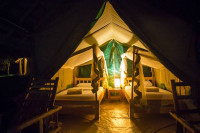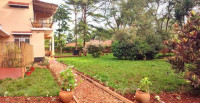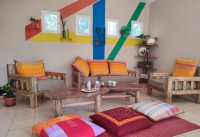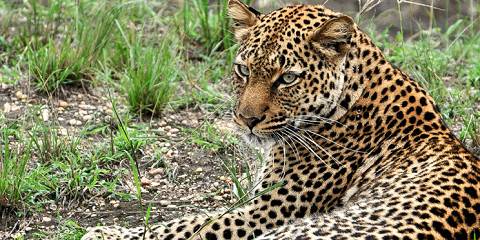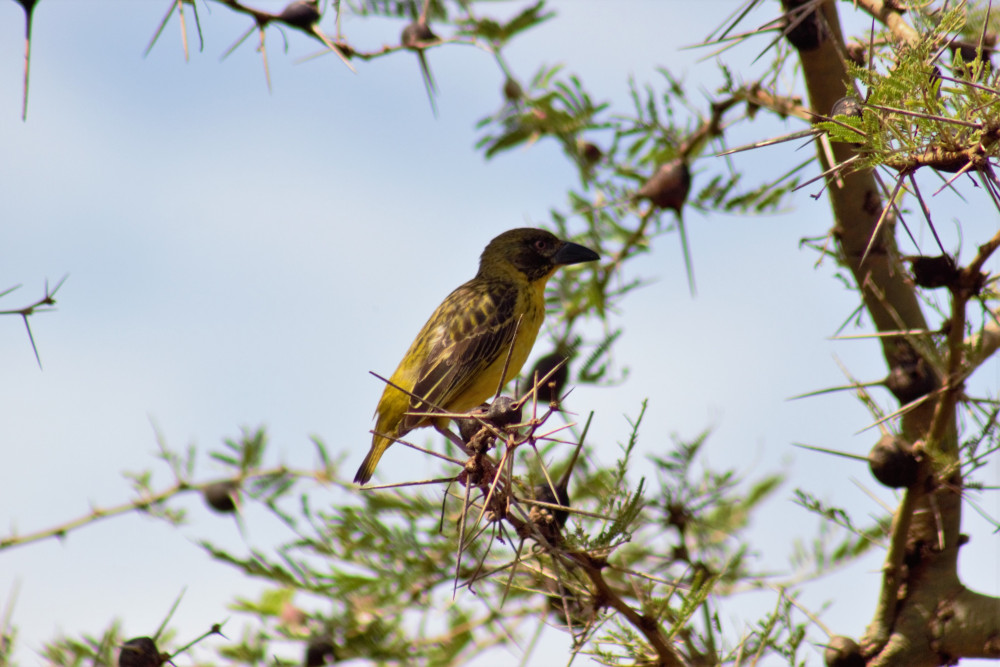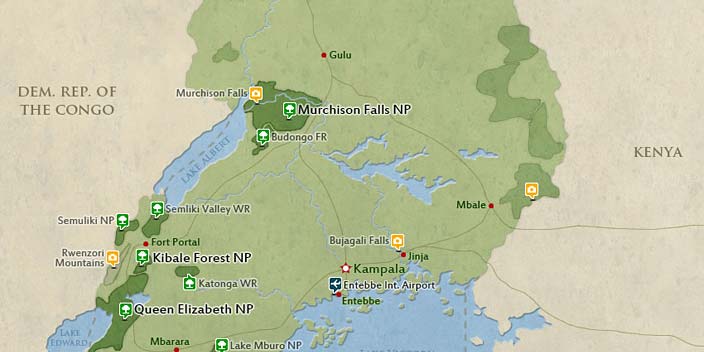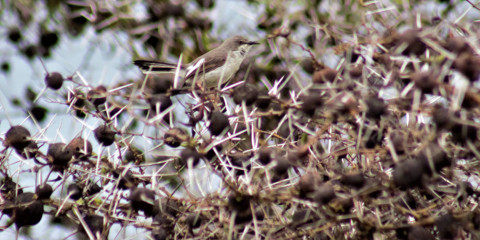
Arrival
Arrival

Day 1
Arrival at the Airport
Arrival at the Airport
You'll arrive late this evening, meet your driver, and transfer to your nearby hotel in Entebbe for dinner and an overnight stay. Early arrivals will be given a chance to bird the nearby Entebbe Botanical Gardens (EBG).
EBG is a beautiful place situated on the northern shores of Lake Victoria, filled with colorful butterflies, birds, and primates in an area of 40.7 ha. The gardens house a collection of species of plants from the tropical, sub-tropical, and temperate zones, besides several shrubs and other plants that regenerated naturally over the years. The habitat has attracted a diverse array of birds —206 species (both forest and shorebirds) and monkeys; black and white Colobus and vervet monkeys.
The bird walk here is more leisurely and relaxed with an introduction to some Afro-tropical species of birds.
- Main Destination:
- Entebbe International Airport (Entebbe)
- Accommodation:
- Forest Cottages
- Meals & Drinks:

Day 2
Mabamba Wetland and Lake Mburo
Mabamba Wetland and Lake Mburo
You'll start early, check out our hotel, and bird to Mabamba wetland in the morning and continue to Lake Mburo in the afternoon. On the way to Mabamba, you'll have numerous stops to look at some species that are normally encountered. While at the swamp, you'll board a canoe driving through a channel of lagoons into the marsh. You'll look out for the shoebill.
Besides the shoebill, there is a selection of common wetland species that we are likely to encounter here including, lesser jacana, African jacana, papyrus gonolek, white-winged warbler, gull-billed terns, white-winged black terns, whiskered terns, common moorhen, swamp flycatcher, Goliath and purple herons, spur-winged and Pygmy geese, African snipe, blue-headed coucal, Carruthers cisticola, northern brown-throated weavers, winding cisticola, white-faced whistling ducks, etc.
You will be here till late morning hours. You will continue to Lake Mburo National Park stopping over at the Equator for lunch.
- Main Destination:
- Mabamba Swamp
- Accommodation:
- Hyena Hill Lodge
- Meals & Drinks:

Day 3
Full-Day Birding in Lake Mburo National Park
Full-Day Birding in Lake Mburo National Park
You'll have morning nature walks in the woods, an afternoon boat ride, and spend the rest of the day on a game drive. Lake Mburo is the only wooded savannah in Uganda where tourists enjoy grazing with wildlife on foot! Most sought-after species here include tabora cisticola, red-faced barbet, possibilities of the rare crested barbet which are only known in the remote north-eastern Tanzania, Rwanda, and here, brown-chested lapwing, chinspot batis, etc.
The boat ride merits specials like the white-backed and black-crowned night herons, rufous-bellied herons, African finfoot, African darters, water thicknee, kingfishers, etc. You will also encounter pools of hippos, crocodiles, and buffalos.
Birding here is a delightful experience, with beautiful scenery and markedly different fauna from other reserves. This is a great place to see game animals such as elands, giraffes, zebras, topi, impalas, and acacia-associated birds.
Birding is delightful with beautiful scenery.
- Main Destination:
- Lake Mburo National Park
- Accommodation:
- Hyena Hill Lodge
- Meals & Drinks:

Day 4
Transfer to Bwindi Impenetrable National Park- Ruhiija Sector
Transfer to Bwindi Impenetrable National Park- Ruhiija Sector
Today, you will check out of your camp, have an early morning breakfast, and drive slowly as we bird on the way to the Ruhiija section of Bwindi Impenetrable National Park. You may have lunch in Mbarara or Kabale depending on your pace and later continue to Ruhiija. Early arrivals will be given a chance to bird along the main road. Your first encounter with the Albertine Rift Endemics begins here. Bwindi is generally at a higher altitude and therefore is cooler. Temperatures range between 10-18°C. Forest birding at Bwindi ranks the best in Uganda and Africa as well. It is home to 23 highly localized Albertine Rift endemics.
- Main Destination:
- Bwindi Impenetrable National Park (Gorillas)
- Accommodation:
- Broadbill Forest Camp
- Meals & Drinks:

Day 5
Birding in Ruhiija – Mubwindi Swamp
Birding in Ruhiija – Mubwindi Swamp
After breakfast, you'll carry your picnic lunch and head for a whole day birding following the famous trail through the forest up to Mubwindi Swamp. The 4km trail to Mubwindi Swamp drops from 2350m to 2050m ASL and is the best place for some of the most difficult to find of all the Albertine Rift Endemics including; the rare and localized Grauer's rush warbler, African green broadbill, the beautiful regal sunbird, and Archer's robin-chat. Mubwindi Swamp trail is home to dwarf honeyguide, stripe-breasted tit, Rwenzori apalis and African / Rwenzori Hill babbler, and Carruthers' cisticola.
Other key species here include Fraser's eagle-owl, purple-breasted sunbird, blue-headed sunbird, Eastern mountain-greenbul, strange weaver, black-headed waxbill, bar-tailed trogon, white-headed wood-hoopoe, waller's starling, Stuhlmann's starling, Ludher's bush-shrike, Handsome francolin, montane oriole and montane nightjar.
- Main Destination:
- Bwindi Impenetrable National Park (Gorillas)
- Accommodation:
- Broadbill Forest Camp
- Meals & Drinks:

Day 6
Ruhiija 'NECK' Birding and Transfer to Buhoma
Ruhiija 'NECK' Birding and Transfer to Buhoma
You will travel to the Buhoma sector of Bwindi Impenetrable National Park while birding on the way —you will do the popular “NECK” birding in the morning. The neck is a relatively narrow stretch separating the two sections of the Bwindi Impenetrable forest. It is characterized by riverine forest vegetation.
Some of the species we are likely to see here include; mountain wagtail, red-tailed and Shelley's greenbul, Cassin's flycatcher, black duck, banded prinia, grey-throated barbet, common buzzard, black-billed turaco, fine-banded woodpecker, dwarf honeyguide, red-tailed greenbul, black bee-eater and cinnamon-chested bee-eater, many-colored bush-shrike, Ayres's hawk-eagle, bronze-naped pigeon, honeyguide greenbul, red-throated Alethe, gray apalis, African shrike-flycatcher, red-headed Malimbe, dusky twinspot etc.
Today, you'll carry a picnic lunch. You will arrive at Buhoma late this afternoon.
- Main Destination:
- Bwindi Impenetrable National Park (Gorillas)
- Accommodation:
- Ride 4 a Woman Guesthouse
- Meals & Drinks:
Day 7
Birding or Gorilla Tracking at Buhoma Sector
Birding or Gorilla Tracking at Buhoma Sector
For those who choose to do the optional gorilla trek, you will set off early after breakfast, carry a packed lunch, and gather at the park headquarters for briefing prior to the activity. Trekking up the hillside to view a family of gorillas nestled in casual, frolicking play is a fascinating, once-in-a-lifetime experience.
For the others, you will start birdwatching early after breakfast, carry a picnic lunch, and begin a whole day birding along the main trail at Buhoma.
Key species here include black-faced rufous warbler, black-faced apalis, black-throated apalis, mountain masked apalis, red-throated alethe, ashy flycatcher, dusky-blue flycatcher, Chapin's flycatcher, black-and-white shrike-flycatcher, dusky tit, blue-throated brown sunbird, Northern double-collared sunbird, sooty boubou, and pink-footed puffback.
- Main Destination:
- Buhoma Sector (Bwindi NP)
- Accommodation:
- Ride 4 a Woman Guesthouse
- Meals & Drinks:

Day 8
Transfer to Queen Elizabeth National Park
Transfer to Queen Elizabeth National Park
You'll start early after breakfast for Queen Elizabeth National Park. This is a rather long journey that may take most of your time this day. You'll have a few stops for stretching your legs, having your packed lunch, and birding on the way. You'll drive through the Ishasha section famed for its tree-climbing lions. Some likely encounters include red-collared, white-winged widow birds, white-headed barbets, and stout cisticola. You will arrive late this evening at your camp.
- Main Destination:
- Queen Elizabeth National Park
- Accommodation:
- The Bush Lodge (Banda)
- Meals & Drinks:

Day 9
Birding in Queen Elizabeth National Park
Birding in Queen Elizabeth National Park
You'll start early this morning after breakfast, you will carry your lunch packs and drive for about 20 minutes to the park. You'll do a birding drive in the savannah area the whole morning. In the afternoon, you'll go for a birding launch cruise along the Kazinga Channel. Kazinga Channel is a narrow neck of water body connecting Lakes Edward and George.
Following one of the numerous trails in the park on a game/birding drive will produce sightings of such species as harlequin quail, blue quail, small (Common) buttonquail, African crake, martial eagle, stout cisticola, black-crowned Tchagra, trilling cisticola, speckle-breasted woodpecker, African skimmer, Verreaux's eagle-owl, pallid and Montagu’s harriers, African crake, marsh tchagra, black coucal, etc.
Our Kazinga Channel launch cruise is the most luxurious in the region; plying these waters with comfort, elegance, and attentive service, affording superb wildlife viewing from your observation deck is far more reassuring!
- Main Destination:
- Queen Elizabeth National Park
- Accommodation:
- The Bush Lodge (Banda)
- Meals & Drinks:

Day 10
Travel to Fort Portal while Birding on the Way
Travel to Fort Portal while Birding on the Way
After an early morning breakfast, you will check out of the lodge and travel to Fort Portal. This afternoon, you'll spend some time birding along the craters in Fort Portal Nyakasura Hills. The hills are famous for the singing cisticola, red-winged Francolin. Along Lake Kigere, you'll look out for the great-crested grebe and little grebes.

Day 11
Birding in Semliki National Park along the Famous Kirumiya Trail
Birding in Semliki National Park along the Famous Kirumiya Trail
You will drive for about 1.5 hrs to the park.
Semliki forest is one of the richest lowland forest birds in Uganda and marks the eastern extension of the great Ituri Forest. A large number of Guinea-Congo biome species reach their eastern limits here.
You will start at dawn after an early breakfast and set off with your packed lunch. You'll spend the whole day bird-watching the Kirumiya trail or any other part of the forest depending on the reliable information from our site guides. Key species include red-billed, black-wattled, black-billed and white-crested hornbills, African piculet, black-chested cuckoo, red-rumped tinkerbird, rufous-sided broadbill, white-bellied, dwarf, and pygmy kingfishers, piping, white-thighed, and African pied hornbills, fire-crested alethe, red-bellied and blue-billed Malimbe, swamp palm bulbul, lowland akalat, forest scrub robin, green-tailed bristlebill, leaf love, chestnut-breasted negrofinches, black-winged oriole, etc.
- Main Destination:
- Semuliki National Park
- Accommodation:
- Koi Koi
- Meals & Drinks:

Day 12
Birding to Kibale National Park
Birding to Kibale National Park
You will start early after an early morning breakfast, check out the hotel, and bird on the way up to Kibale Forest. You will check in your lodge shortly before lunch, bird around the lodge premises or have a siesta.
This afternoon, you'll bird in the Bigodi Papyrus Swamp. Bigodi Wetland Sanctuary is a community-owned and managed nature reserve. A 4km trail has been created in the wetland adjacent to the forest. The habitat here consists of a swamp surrounded by low, scrubby secondary forest and cultivation. Key species include among others; white-spotted flufftail, green-backed twinspot, cabanis and joyful greenbuls, scaly-breasted Illadopsis, olive-green Camaroptera, white-collared oliveback, white-winged warbler, white-chinned prinia, blue-shouldered robinchat, lesser honeyguide, Uganda spotted and speckle-breasted woodpeckers, white-tailed ant-thrush, red-capped robinchat, rufous flycatcher-thrush, great sparrow-hawk, red-headed bluebill, and Luhdher's bushshrike.
- Main Destination:
- Bigodi Wetland Sanctuary (Kibale NP)
- Accommodation:
- Chimpanzee Forest Lodge
- Meals & Drinks:

Day 13
Morning Birding in the Forest and Afternoon Chimp Tracking
Morning Birding in the Forest and Afternoon Chimp Tracking
Kibale is an extensive national park, protecting a large block of rainforest that offers excellent birding with 335 species recorded. Kibale protects a remarkable 13 primate species, including the very localized red Colobus and L'Hoest's monkey, Galagos, blue monkey, black and white Colobus, red-tailed and vervet monkey.
After an early morning breakfast, you'll carry our picnic lunch and make a very early start for the forest. Our target today should be among many other species, the most sought-after bird; the green-breasted Pitta. Today, you should also be treated to the numerous treasures of this forest, to mention but a few; African crowned eagle, Afep pigeon, red-winged francolin, black-billed turaco, Narina trogon, black bee-eater, white-headed wood hoopoe, yellow-rumped tinkerbird, African pitta, grey-winged robin-chat, African broadbill, willcock's, scaly- throated and thick-billed honeyguides.
- Main Destination:
- Kibale National Park (Chimps)
- Accommodation:
- Chimpanzee Forest Lodge
- Meals & Drinks:

Day 14
Travel to Masindi Town
Travel to Masindi Town
You will wake up this morning; have breakfast and set off for the Budongo Area. This is another long journey that may take the whole day with chances of birding on the way. Stop overs will be done at strategic points to provide opportunities for birding, stretching legs, and enjoying your picnic lunch. Arrival in Masindi will be late this evening.
- Main Destination:
- Budongo Forest (Chimps)
- Accommodation:
- Masindi Hotel
- Meals & Drinks:

Day 15
Birding in Budongo Forest Reserve along the “Royal Mile”
Birding in Budongo Forest Reserve along the “Royal Mile”
You will have an early morning breakfast, carry a picnic lunch, and drive to one of “Uganda's bird-watching hotspots”, the Royal Mile. This is Uganda's historically known leisure spot for the traditional King of Bunyoro, hence the name “Royal”. This forest comprises very huge mahogany trees. Here, the forest has been cut back a few meters along the sides of the main trail providing an excellent viewing area. Birds cavort and skulk in the canopy — most of these being the most challenging Allethes, illadopses, and greenbuls.
Key species include; African dwarf and chocolate-backed kingfisher, yellow and grey long bills, olive-bellied crombec, brown-eared woodpecker, crowned eagle, forest flycatcher, yellow-browed camaropera, African emerald cuckoo, yellow-mantled weaver, yellow-browed camaroptera, green crombec, crested and red-headed Malimbe, red-headed bluebill, white-thighed hornbill, yellow-spotted and yellow-billed barbets, Sabine's and Cassin's spinetail.
- Main Destination:
- Budongo Forest (Chimps)
- Accommodation:
- Masindi Hotel
- Meals & Drinks:

Day 16
Birding in Murchison Falls National Park
Birding in Murchison Falls National Park
This day, you'll have an early morning breakfast, check out the lodge, and transfer to Murchison Falls National Park as you bird on the way through the park up to the top of the falls. Lunch will be at our lodge. This afternoon, you'll do a launch cruise along the Nile River up to the bottom of the falls.
This is Uganda's largest National Conservation area and it is famous for its big game, spectacular scenery, and the falls for which the park was named. Abundant hippos, Crocodiles, elephants, buffalos, Uganda kobs, and waterbucks can be seen along with lions, leopards, and patas monkeys.
Among a huge variety of widespread African bird species in the wetlands and various dry savanna and open woodland habitats are more special birds: Stanley's bustard, saddle-billed stork, rock pratincole, little sparrowhawk, Bruce’s green-pigeon, red-necked falcon, Senegal thick-knee, long-toed plover, blue-headed coucal, white-crested turaco, heuglin's francolin, and Abyssinian ground hornbill.
- Main Destination:
- Murchison Falls National Park
- Accommodation:
- Red Chilli Rest Camp
- Meals & Drinks:

Day 17
Birding the Northern Sector of Murchison Falls National Park
Birding the Northern Sector of Murchison Falls National Park
Birding the Northern bank of the park and afternoon launch cruise along the Nile River. After an early morning breakfast, this day, you will check out this camp, carry a packed lunch, and cross the Nile for birding on the northern bank of the park. The northern part of the park provides prime wildlife viewing.
- Main Destination:
- Murchison Falls National Park
- Accommodation:
- Fort Murchison (Tent)
- Meals & Drinks:

Day 18
Travel to Kidepo Valley National Park
Travel to Kidepo Valley National Park
You will start early after breakfast, check out here, and embark on a rather long, teeth-jeering journey to the remote Karamoja area. Nestled in the extreme northeastern corner of Uganda, bordering Sudan and Kenya, Kidepo Valley National Park is Uganda’s wildest and most spectacular conservation area. You will have lunch in Kitgum town and continue driving on the rough roads all the way to the park.
- Main Destination:
- Kidepo Valley National Park
- Accommodation:
- Apoka Rest Camp
- Meals & Drinks:

Day 19
Game Drive / Birding in Kidepo Valley National Park
Game Drive / Birding in Kidepo Valley National Park
The park is famed for protecting remarkable wildlife that is not represented in any other Ugandan protected area. Much of the flora and fauna in the park is typical of northern Kenya.
The birdlife is rich with a recorded bird list of 468. There are over 60 bird species listed here and have not been recorded in any other Ugandan national park. The park is outstanding for its birds of prey. Of 58 species recorded 14 are believed to be endemic to the region. Among those are Verreaux’s eagle, Egyptian vulture, lesser kestrel, and pygmy falcon. Other interesting species include birds like the Karamoja apalis, kori bustard, red-billed hornbill, yellow-billed and Jackson’s hornbill, heuglin’s weaver, cut-throat finch, sand grouses, etc. Various and unique antelopes like greater kudu, lesser kudu, Guenther’s dik-dik, and mountain reedbuck are found nowhere else in Uganda. Primates like the localized patas monkeys are abundant and five species have been recorded.
- Main Destination:
- Kidepo Valley National Park
- Accommodation:
- Apoka Rest Camp
- Meals & Drinks:

Day 20
Travel to Pian-Upe Wildlife Reserve
Travel to Pian-Upe Wildlife Reserve
You will check out Kidepo and drive to Pian-Upe with some birding on the way. This is such a very long journey that may take most of your time in the day. This is quite a birdy road via Moroto and Nakapiripirit — it's halfway rough, half-way smooth. You'll arrive in Pian-Upe in time to do some birding around the camp before dark. Optional night drive.
- Main Destination:
- Pian-Upe Wildlife Reserve
- Accommodation:
- Pian-Upe Bandas
- Meals & Drinks:

Day 21
Birding in Pian-Upe Wildlife Reserve
Birding in Pian-Upe Wildlife Reserve
The special trip today is to look for Uganda’s only endemic, the fox’s weaver and Karamoja apalis. Other species that may be of interest include the bronze-tailed starling, yellow-billed shrike, Boran cisticola, etc.
You will have a late lunch in Mbale town. Later, you will transfer to Jinja town.
- Main Destination:
- Pian-Upe Wildlife Reserve
- Accommodation:
- Jinja Backpackers
- Meals & Drinks:

Day 22
Morning Birding in Mabira Forest Reserve and Afternoon Transfer to Entebbe Airport for your Flight
Morning Birding in Mabira Forest Reserve and Afternoon Transfer to Entebbe Airport for your Flight
This is the only semi-deciduous tropical rainforest remaining in central Uganda protecting a big chunk of the lowland forest species. The forest is just 25km from Jinja Town.
Key species here include among others Nahan’s francolin, Cassin’s hawk eagle, green-tailed bristlebill, grey longbill, leaf love, paradise flycatcher, sooty boubou, sooty flycatcher, yellow-breasted, buff-throated and black-throated Apalis, purple-throated cuckoo shrike, red-headed bluebill, black-bellied seedcracker, speckle –breasted woodpecker, African blue flycatcher, and grey-crowned Negrofinch, forest robin, snowy-headed robin-chat, grey-capped warbler, black-and-white flycatcher, dusky tit, common wattle eye, African emerald cuckoo, olive green camaroptera, tit hylia, western-violet backed sunbird, black and white shrike flycatcher, dusky blue flycatcher, Jameson’s wattle-eye, hairy-breasted barbet, dusky long-tailed and red-chested cuckoo, yellowbill, blue-shouldered robin-chat etc.
- Main Destination:
- Mabira Forest Reserve
- Accommodation:
- No accommodation (End of tour)
- Meals & Drinks:


